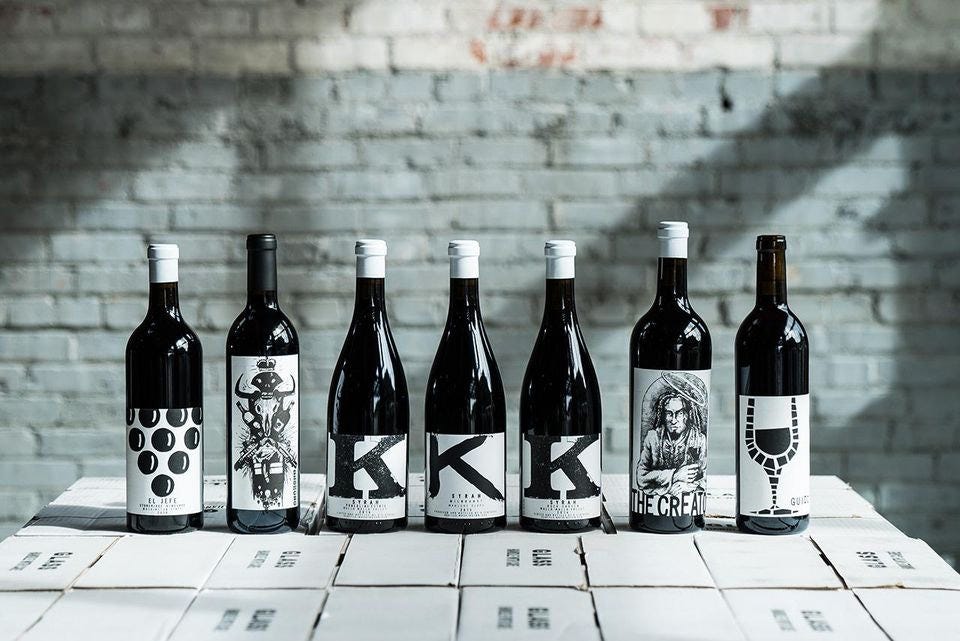Use your audience’s language, not yours
Charles Smith is one of America’s most influential winemakers. But his success didn’t happen overnight.
In 2001 Smith went to see Matt E. Tucker, Commercial Vice- President of Banner Bank.
Smith needed $250,000 to launch a winery in Walla Walla, Washington.
Smith did’t look like most winemakers, he looked more like a lost member of The Ramones.
Smith had a funky business plan, listing the vineyards he was working with and how much he had in bottle. And that was it.
So Tucker says: "First, we have to try your wine".
Smith comes back the next day with two bottlings from his initial vintage, 1999.
Tucker loved it, “Congratulations, you now have a $250,000 credit line. Your wine is the collateral.”
Banner Bank was taking a big risk. Smith spent 9 years managing rock bands in Scandinavia. But he was a newbie in the wine business.
It turns out Smith was a marketing genius.
I remember reading a Wine Spectator interview with Smith a few years ago. Smith said something you rarely hear winemakers say:
“When people drink it they feel good about what they bought. It’s not about me, it’s about everyone else.”
Then he adds, “The simplicity of the label is almost like a courtesy. You’re going to help me pay my bills and survive, and I’m going to talk over you? No, I’m going to communicate in your language. The packaging tells the story.”
Smith knew most people don’t speak wine. So he communicated in a language they understand.
He created simple but distinctive black-and-white labels. And called his wines easy to remember names like K Syrah, Velvet Devil Merlot or Kung Fu Girl Riesling.
In 2016 Smith sold 5 of his best-known wine brands to Constellation Brands for $120 million.
Photo credits: K Vintners
Takeaways for your business:
1. Most marketers focus waaaaaaay too much time, energy and $ chasing trends and fads. Marketing’s real job is to understand human behavior and learn how to turn it into a competitive business advantage.
2. When you start writing copy make sure that you use your audience's language, not yours. Be personal and imagine yourself chatting face to face with your reader.
3. Read out loud what you just wrote. If you sound like a Politician talking, it’s time to re-write everything from scratch.
4. I want you to keep a voice diary. If you haven’t started one yet, do my The Netflix voice diary copywriting exercise (scroll down to read it).
5. Remember what I told you about confirmation bias: Your readers are looking for information that confirms they're making the right choice. So use their biases to your advantage.
Hit reply if you have any questions.
Your pal,
Miguel Ferreira
Founder & Chief Copywriter, Teardwn + Nishi + Copy Ipsum
(Because most of your competitors don't have access to a good copywriter. Work with me).
✍️ The Netflix copywriting technique (Create a voice diary)
Your clients are going to buy your brand, your products, your solution because of your voice. Because, in some way, your voice reminds them of theirs. That's why you should never "write copy". You should "assemble copy".
Most people write copy because it's the easy way. Most people who write copy write to impress the client or themselves. But when you assemble copy you're not trying to impress anyone. You're just using the same kind of language your audience uses. So you adjust your voice to the voice of your clients. And because of that they feel more connected to your brand. Because you talk like them.
So here's what I want you to do. I call this the Netflix copywriting technique.
I want you to keep a voice diary. This is going to involve detective work, so I want to do a few things:
1. Buy a Moleskine notebook (or from any other brand, as long as it’s a physical notebook that’s fine).
2. Next, I want you to think about the person more likely to buy or influence purchase of whatever products you sell.
But forget about the standard target audience demographics yada yada yada. Forget about age, income, etc. I want you to think about psychographics. I want you to think in culture, not audiences. So imagine that person more likely to buy or influence purchase. What's their favorite Netflix show? Figure it out.
3. Over the next 4 weeks I want you to watch that Netflix show religiously. And I want you to use your physical notebook and make four separate sections.
In the first section write down words and phrases that made you curious.
In the second section write down words and phrases that made you laugh.
In the third section write down words and phrases that made you feel energized.
In the fourth section write down words and phrases that made you feel surprised.
Why is this a useful writing exercise ?
If your brand is struggling to find it’s voice, the first thing you should figure out is to determine who's your audience and what kind of language they use. And the Netflix copywriting technique exercise is perfect for that. Because there’s a reason why your target audience loves the Netflix show you identified. They love the language used by that show. Because it reminds them of theirs.
So give the Netflix copywriting technique a try, and in 4 weeks you’ll have a clear idea of what your brand voice truly sounds like.
You’re on the free list for Creative Samba. For the full experience, become a paying subscriber. My paid newsletter is packed with actionable insights about copywriting, marketing and how the human mind works. So you can learn how to think & write more creatively — like Pro copywriters do.





